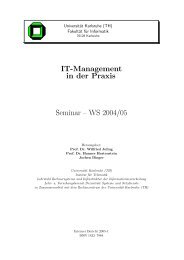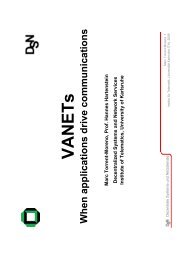Download PDF - KIT
Download PDF - KIT
Download PDF - KIT
Create successful ePaper yourself
Turn your PDF publications into a flip-book with our unique Google optimized e-Paper software.
Transmission power [dBm]<br />
18<br />
17<br />
16<br />
15<br />
14<br />
13<br />
12<br />
11<br />
TWindow = 2s<br />
TWindow = 4s<br />
TWindow = 6s<br />
10<br />
1 2 3 4 5 6 7 8 9 10<br />
Packet generation rate [Hz]<br />
Fig. 10. Communications configurations that satisfy the application requirements<br />
with the target reliability (Dw and pappA = pappB = 0.99),<br />
considering a traffic density of 15 veh/km/lane.<br />
distance. However, if vehicle A is aware of the presence of<br />
vehicle D through the reception of one of its beacon messages,<br />
it can assume that vehicle B would have been informed by<br />
vehicle D that it cannot conduct a lane-change maneuver. As<br />
a result, if vehicle D is located at a distance lower than DwA<br />
from vehicle A, then vehicle A does not need to transmit<br />
with the power level required to guarantee papp at DwA.<br />
In this context, vehicle A can reduce its transmission power<br />
to that needed to communicate with vehicle D, located at a<br />
distance Df from vehicle A (see Figure 9b). Consequently,<br />
each vehicle can configure its transmission parameters based<br />
on the minimum of the Dw and Df distances. This results<br />
in vehicle A configuring its transmission power to directly<br />
communicate with vehicle B only when there is no vehicle<br />
D in the same lane ahead located at Df < Dw. Therefore,<br />
the use of traffic context information obtained through the<br />
periodic exchange of broadcast messages allows the reduction<br />
of unnecessary interference and limits the channel load with<br />
respect to a basic approach.<br />
Figure 11 shows the average channel busy time for the basic<br />
and traffic contextual approaches previously described. The<br />
results shown in the figure have been obtained for a highway<br />
scenario with 6 lanes, different traffic densities (D1 = 7.2,<br />
D2 = 9.6, and D3 = 14.4 veh/km/lane) and packet<br />
generation rates of 2Hz and 10Hz. It is important to note<br />
that all the configurations reported in this figure were able to<br />
satisfy the target application’s reliability. As it can be observed,<br />
the traffic contextual extension of awareness control policies<br />
can significantly reduce the channel load (more than 50% in<br />
some cases) while guaranteeing the application requirements.<br />
The obtained results also demonstrate that the reduction of<br />
the packet generation rate can also decrease the channel load<br />
generated, despite the fact that it would require a higher<br />
transmission power to meet the application requirements (see<br />
Figure 10).<br />
VI. OUTLOOK<br />
The design of future cooperative vehicular systems could<br />
certainly require the joint consideration of congestion and<br />
CBT [%]<br />
12<br />
10<br />
8<br />
6<br />
4<br />
2<br />
0<br />
D1 D2 D3<br />
Traffic density<br />
(a)<br />
Basic Traffic contextual<br />
CBT [%]<br />
35<br />
30<br />
25<br />
20<br />
15<br />
10<br />
5<br />
0<br />
D1 D2 D3<br />
Traffic density<br />
(b)<br />
Fig. 11. Channel busy time for the communications configuration that satisfy<br />
the application requirements with the target reliability (Dw and pappA =<br />
pappB = 0.99), considering a payload of 500 Bytes. (a) 2Hz (b) 10Hz<br />
awareness control protocols. Under certain conditions, the congestion<br />
control limitations could prevent the proper function<br />
of multiple applications running on neighboring vehicles. This<br />
could arise in scenarios such as the one illustrated in Figure 1.<br />
In this scenario, the requirements of the lane change assistance<br />
application run by the vehicles under free flow conditions<br />
would be notably different from the requirements of the applications<br />
run by the vehicles in the traffic jam. While awareness<br />
control protocols would adapt each vehicle’s communications<br />
parameters to efficiently satisfy their individual requirements,<br />
congestion control protocols would limit the channel load<br />
generated, given the high density of vehicles in the scenario.<br />
As a result, the requirements of all the different applications<br />
might not be simultaneously satisfied. This example indicates<br />
the obvious challenge of how to integrate both control aspects<br />
into one system, in particular if the selected actions and<br />
adjustments are contradictory. The fundamentally different<br />
objectives lead to the issue that a joint realization might be<br />
difficult to realize or even mutually exclusive. One potential<br />
approach to address this problem is based on the use of<br />
additional policies to prioritize among different applications<br />
and control the amount of information sent to the wireless<br />
channel. An example of this type of policy was proposed<br />
in [43], based on application-specific utility functions and a<br />
prioritization and rescheduling technique.<br />
In addition to the joint consideration of congestion and<br />
awareness control, future cooperative vehicles might need to<br />
run different applications simultaneously. As a result, they<br />
should be able to simultaneously support potentially different<br />
(and maybe contrary) communication and application requirements.<br />
How to efficiently satisfy these requirements while<br />
efficiently using the communications channel is a challenging<br />
aspect that would need to be carefully investigated in<br />
the coming years. Considering only safety applications for<br />
illustration purposes, these applications might need to detect<br />
or monitor neighboring vehicles in the various safety areas<br />
shown in Figure 12. For the example shown in this figure,<br />
vehicle A might need to simultaneously run a cooperative<br />
forward collision warning (CFCW) application with vehicle<br />
14




